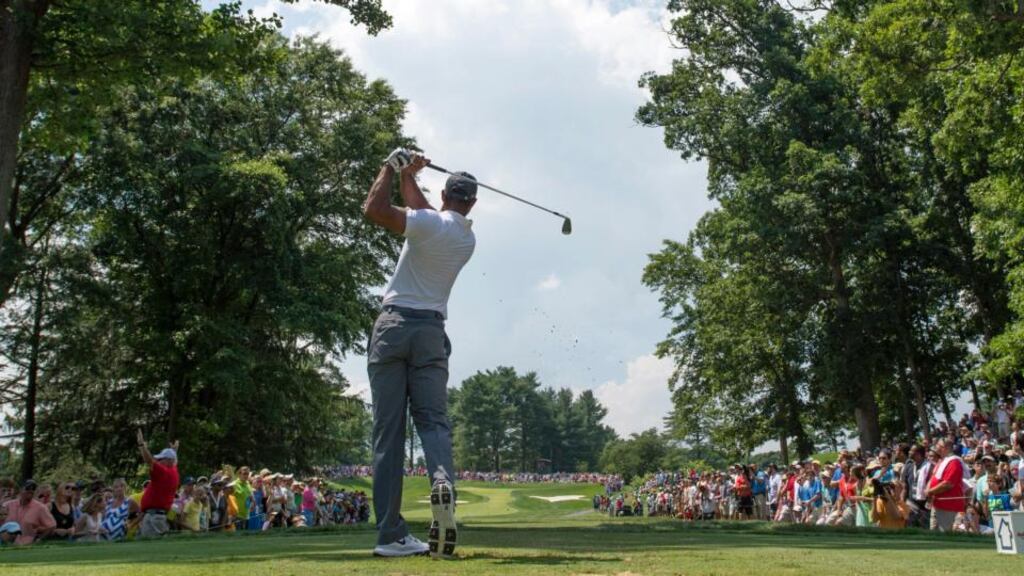Just over four years ago, somewhere between Tiger Woods' emergence from self-inflicted exile and him teeing it up at the 2010 Masters, one of the most succinct appraisals of his importance to his sport came via a Saturday Night Live comedy sketch.
"Tiger Woods will return to golf in three weeks," announced the fake newscaster. "Also returning to golf in three weeks – viewers!"
The gag may ring even truer now than it did then. It also goes some way to explaining why this morning ESPN is dedicating an entire channel to covering Woods’ every move at the British Open. All Tiger, all the time. Every shot, every sweary outburst at treacherous balls refusing to land on fairways.
Never mind he’s six years removed from his last major victory and missed the cut in his only competitive start since back surgery, the hope is all over America, fans (many, surreptitiously, on their phones and office computers) will watch the so-called Tiger-cam from Hoylake. Perhaps the only surprise is somebody didn’t think of this sooner.
In Woods’ absence, last month’s US Open garnered the smallest television ratings since 1996, down almost 50 per cent from the previous two editions.
This year’s Masters had its worst audience for a decade. For just about every televised tournament these days, the graph is on a similar downward trajectory.
Only one man appears box office enough to bring people back to the game but he needs to find form and fitness to make that possible.
That ESPN may have to reconfigure the entire raison d’etre of the Tiger channel should he fail to make the cut tomorrow night captures the difficulties besetting golf.
When it comes to Woods, the American television networks are reaping what they sowed. Since his US Amateur victory in 1996 outdrew a professional tournament that same day, they oversold him to the detriment of almost every other player, bar Phil Mickelson.
Breaking with all usual criteria, Sunday broadcasts used to feature nearly every Woods shot regardless of whether he was genuinely contending.
Oftentimes, commentators almost fraudulently talked up his chances of making unlikely runs on the back nine even though he might have been several shots adrift of the leaders. Anything to justify keeping him onscreen rather than showing stars of lesser wattage.
That was all very well when Woods was only ever a couple of weeks away from winning and/or doing something wondrous. Now he has been reduced to a mere mortal, the networks have a serious credibility problem.
Having spent so long declaring Tiger the only show in town, they are struggling to convince casual viewers Rory, Bubba, Jordan et al are all headline acts too.
Golf purists know that to be true but event junkies, weaned on a diet of Woods at his peak, aren’t interested in any substitutes.
Beyond the disappearing couch potatoes, golf is, in so many ways, still coming to terms with the fall-out from "The Tiger Bubble", what the New York Times called the decade-long period of unbridled growth in interest, television audiences, playing numbers and prize money after Woods came along.
Even before the tawdry events of Thanksgiving night 2009 forced a re-appraisal of the man and the myth, that bubble had burst because (this may sound all too familiar) golf had over-extended itself and was due a rather punishing market correction.
Five million Americans have stopped playing golf over the past decade. A staggering number that also explains why 643 18-hole courses closed between 2006 and 2013. Last year alone, 157 shut their gates for the last time while just 14 new facilities opened.
Of course, these telling statistics have more to do with the recession and the travails of the country’s middle-class than with Tiger getting marooned on 14 majors.
Yet, they are connected too because Woods’ peak years coincided with the course-building boom and the arrival on tees of people who’d never picked up a club before.
If the television suits are banking on Woods miraculously rediscovering his mojo one of these weeks – witness The Golf Channel showing his press conference live from Liverpool before dawn had even broken on America's east coast the other morning – those who run the sport are being more proactive about arresting the decline in interest.
Next Wednesday marks the USGA’s first Play9 day which they are promoting as an opportunity for lapsed golfers to return, even if only for half a round.
While Jack Nicklaus is among those calling for recreational rounds to be 12-hole affairs, taking account of the fact so few people have time to regularly play 18, the PGA of America is considering even more radical initiatives.
These include introducing competitions where the hole is 15 inches wide and rewriting the rules to allow amateurs to use special clubs with enhanced power and to hit juiced balls that fly farther. Anything to make the game easier, faster, and more fun. Essentially, anything to make the game feel the way it looked when Woods played it in his pomp.
“People want to watch history,” said Dick Ebersol, then chairman of NBC Sports, when explaining Woods’ ability to bring non-golf fans to the screens, “and Tiger is history.”
For golf, the bigger problem will be if his days of winning majors prove to be history too.













